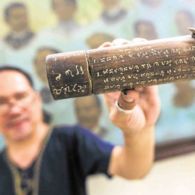Profile
When the Spanish arrived in the Philippines in the 1500s, they discovered to their surprise that the people of those islands were already literate. A Jesuit priest, Father Pedro Chirino, wrote, “So accustomed are all these islanders to writing and reading that there is scarcely a man, and much less a woman, who cannot read and write in the letters proper to the island of Manila.”They had been writing for perhaps a century in a script they called baybayin, a term that more or less means “alphabet,” from the root baybay, meaning “spell.”
“When they write,” announced an anonymous Spanish report in 1590, “it is on some tablets made of the bamboos which they have in those islands, on the bark. In using such a tablet, which is four fingers wide, they do not write with ink, but with some scribers [the tip of a knife, or a sharp piece of iron] with which they cut the surface and bark of the bamboo, and make the letters.”
And once the letters had been cut, the writer took a handful of ash and rubbed it into the thinly-incised letters to make them stand out more clearly.
Interestingly, the very way in which the letters were formed meant that Western observers were thoroughly confused: in which direction was the Baybayin written, and in which should it be read? Some thought the text should be read vertically from bottom to top in columns progressing from left to right because that was how the ancient Filipinos carved it. This writing process, though, had nothing to do with linguistics and everything to do with occupational safety. Given that they were carving with a sharp tool on an irregular and non-flat surface, they carved away from their bodies. This actually gave them the unusual ability to read and write in different directions and from different angles. To add to the confusion, mirror writing was common, so it was not unusual to see left-handed and right-handed versions of the same letter.
Once the Spanish arrived, Baybayin was doomed to the long, slow decline of a minority writing system. In short order, printing presses were set up and Filipinos adopted the use of pen, paper and ink, so the technological basis for their written language, and thus its very look, was lost.
Even though the Spanish friars adapted Baybayin for printing and used it to teach Christianity to the Filipinos (and to teach other clerics how to speak the local languages), it began to lose headway in the 1600s. Filipinos continued to sign their names with Baybayin letters throughout the 17th, and even into the 18th century, but most documents were written in Spanish.
Baybayin declined in part because it couldn’t handle the new Spanish-influenced sounds that were making their way into Tagalog: it couldn’t distinguish, for example, between the vowels i and e, or u and o, or the consonants d and r.
The issue of power, and the language of power, also played a major part, as it does whenever one culture invades, conquers, annexes or otherwise takes over another. Filipinos found the Latin alphabet easy to learn, and being able to use it helped them to get ahead in life under the Spanish regime, working in relatively prestigious jobs as clerks, scribes, and secretaries. (The closely related script of Tagbanwa, on the island of Palawan, similarly declined.)
All the same, the Baybayin never quite died out, and today a variety of people are doing what they can to revive it.
Baybayin tattoos are returning as signs of cultural pride, and overall cool. One artist, Kristian Kabuay, has expanded his repertoire to include calligraphy, graffiti, and custom artwork — a panorama of Baybayin.
Meanwhile, the Philippine government has added Baybayin symbols to the country’s peso banknotes as an anti-counterfeiting measure. What could be a stronger sign of acceptance than having a script literally backed by the nation’s currency?
In fact, the Philippine government has shown global leadership in this arena. Writing, “The importance of writing in general and the alphabet in particular for the preservation and progress of civilization is incalculable,” in April 2018 the House of Representatives proposed An Act Promoting Philippine Indigenous or Traditional Writing Systems and providing for their Protection, Preservation and Conservation.”
The Act includes:
- Mandating the Department of Education (DepEd) and the Commission on Higher Education (CHED) to include the writing systems in relevant subject of the basic and higher education curricula and create an elective or specialized course in higher education for the same;
- Creating and supporting activities that promote the awareness of the writing systems during Buwan ng Wika and other similar occasions and events;
- Conducting seminars, conferences, conventions, symposia, and other relevant activities on the study of the writing systems, taking consideration of the writing system that is indigenous to a particular region; and
- Ensuring the proper record-keeping of relevant documents and preservation of oral evidence on the writing systems.
There has also been discussion of specific ways of implementing traditional writing systems into commercial and administrative daily life, by requiring: all manufacturers of locally produced processed food products to inscribe local scripts and their translation on the containers of labels; local government to include the appropriate local signage for street names, public facilities, public buildings, and other necessary signage for other public service establishments like hospitals, fire and police stations, community centers and government halls; newspaper and magazine publishers to include an indigenous-script translation; and the dissemination of knowledge and information about local scripts by distributing reading materials in all levels of public and private educational institutions and government and private agencies and offices.
It is very, very unusual for any government to view its own indigenous people and their writing systems with such respect, and to propose such far-reaching legislation. The legislation is still a long way from being concluded and enacted, but the Philippines may be showing the world the way ahead.
You can help support our research, education and advocacy work. Please consider making a donation today.
Links
General script, language, and culture resources
- Omniglot
- Wikipedia
- Unicode (PDF)
- Scriptsource
- Tagalog
- Baybayin.com
- Baybayin is making a comeback thanks to millennials
- E-game that teaches the Baybayin script
- Baybayin card game
- 3 Baybayin Studies (book)
Community support
- Baybayin: Resurrecting Filipino Calligraphy
- Baybayin Movie – The Palawan Script
- The Palawan Script
- Baybayin, The Ancient Script of the Philippines
- Baybayin Bill Article
- Bill Promoting Indigenous Writing Systems










